In the 1970s, Aubrey ‘Po’ Powell was one of the creative minds behind the design agency Hipgnosis. Powell, along with his partner, the late Storm Thorgerson, stripped away the album title and even the band name, and stuck a picture of a cow on the cover of Pink Floyd’s Atom Heart Mother and a prism on the sleeve of The Dark Side Of The Moon instead.
Hipgnosis revolutionised album sleeve art with their elaborate and often surreal imagery for Floyd, Led Zeppelin, 10cc, Black Sabbath, Peter Gabriel and more. Hipgnosis folded in 1983 and Powell went on to a highly successful career directing documentaries, films and TV commercials. However, prior to Storm Thorgerson’s death in 2013, he began collating Hipgnosis’ past work, discovering forgotten negatives and contact sheets, “some of which,” he explains, “had been lying in the bottom of a cupboard for over forty years.”
A new handsome hardback book, Hipgnosis Portraits, offers a journey through a golden age of rock: with unseen outtakes from album cover shoots, rejected artwork and Powell’s previously unpublished photo sessions with some of the biggest bands in the world.
“I captured these artists when they were at their peak,” says Po now. “Floyd, Zeppelin, the Stones – they looked their best, they were playing their best, and they were making the best music of their lives.”
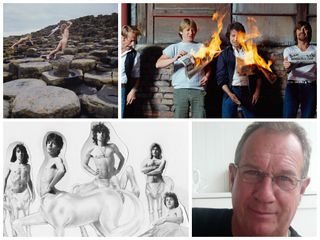
**Aubrey Powell: **In 1973, Marshall Chess [the head of Rolling Stones Records] asked us to a meeting at Keith Richards’s house in Chelsea, with Mick and Keith to discuss a cover for the new Stones album. They told us it was called Goats Head Soup.
We worked up two ideas – one of the Stones as centaurs – half man, half horse – and another as satyrs – with goat’s legs. At the time the Stones had this satanic image, so putting an animal’s legs on them was seen as devilish. They loved it! I explained to them that they’d have to wear tights for it, but Keith said: ‘Yeah, man, okay, whatever.’
So we booked Bow Street studios in Covent Garden one Saturday, and catered for their every whim – beer, Jack Daniel’s, you name it. They were all co-operative, except for Keith who turned up incredibly late and in a foul mood, and that set the others off. Bill Wyman, in particular, was not comfortable.
Eventually, though, things mellowed. Marshall had asked us to shoot some promo pics as well. That’s when they loosened up, sitting around on this mattress, listening to the music we had playing in the studio, and the vibe improved.
Everyone was happy, and we said we’d mock up the pictures of them with animals’ legs and send them something in three weeks’ time. Remember, this was in the days before Photoshop. In the meantime, though, the Stones did a promo session with David Bailey, including a shot of Mick with a piece of cheesecloth over his face in front of a wind machine. Next thing, we took a call from Marshall, saying they were going with the Bailey shot for the album cover. Very rarely did we work on spec, without getting paid, but we’d done it because it was the Stones.
Mick and Keith kept the rough we had made with the horse bodies. I didn’t know it still existed, until their archivist saw the Hipgnosis stamp on the back, and returned it to me. A year ago, I found the photos from the session in a Gaffer-taped envelope in a cupboard in Storm’s studio, unopened since I’d thrown them in there over 40 years ago. The negatives were still in perfect condition.
I love these shots because they capture the Stones in their prime. Mick looked like Nureyev, and Keith like this gigolo pirate. Very beautiful. They weren’t a sixties pop group anymore, but it was them before they could became gnarled and grizzly.
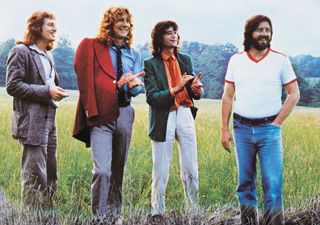
Powell: One day in 1972, I answered the phone at Hipgnosis, and the voice at the other end said: “This is Jimmy Page of Led Zeppelin. Are you the guys that did the artwork for Wishbone Ash’s Argus? Would you be interested in some ideas for Led Zeppelin?” Jimmy loved the Argus cover, apparently. He called me back two days later and told me the title of the new Led Zeppelin album was Houses Of The Holy [1973], and that their very imposing manager, Peter Grant, would be in touch soon.
Two weeks later we went to see Peter and Jimmy, and showed them some roughs. Of course in those days there wasn’t computer-generated graphics, we drew things on napkins and A4 sheets of paper – and neither Storm nor I could draw very well. But we showed them a sketch and described a science-fiction family running up the Giant’s Causeway in Northern Ireland.
Initially I shot the cover of a naked family being led to salvation by this bald, Silver Surfer-style figure. It was an idea borrowed from Arthur C Clarke’s novel Childhood’s End. But at the time I thought it looked awful. It had been raining and I had this idea in my head of golden colours, which is what we ended up doing on the final Houses Of The Holy cover, with just the children climbing up the rocks with this gorgeous orange sunset.
But when I looked through the old Hipgnosis files I found the transparencies of the original family picture, and I thought it looked great. I don’t know why I didn’t use it.
Led Zeppelin were a great band to work for, because there was trust there. They trusted us to go and shoot a great cover, but Peter Grant’s last line was always, ‘Don’t fuck up.’ When we pitched the black object for the cover of Presence [1976] we showed them this model we’d had made. I always remember Robert Plant saying how much he loved it, then turning over the model, and seeing written on the back the crossed-out names of the other groups we’d shown it to before – Wishbone Ash, 10cc, Uriah Heep… Robert said: “You’ve sent this to other people? You and Storm are a pair of fucking chancers!” I said: “But Robert, a good idea’s a good idea…”
Led Zeppelin were great, but Zeppelin on a bad day could be very bad indeed. I travelled on [private plane] The Starship with them when they had [hard man and bit-part actor] John Bindon doing their security. I was a little more ‘sensitive’, shall we say, than some of those guys, so it could get a little heavy, which was when Peter Grant would always say: “Po, you come and sit down here with me.”
Peter phoned me before Zeppelin played Knebworth [in 1979] and asked me to take some promo pictures of them in the field where they were going to be playing. But he warned me that they hadn’t spoken to each other for a few months, Robert and Jimmy weren’t getting along, and Bonzo was not in good shape, as he’d been indulging a little too much.
I thought the best thing to do was to arrange a distraction. I hired a stripper, told her to drive to Knebworth and to park up behind me, where I’d be taking photos of the band, to get out of her car, stick a radio on the bonnet and start stripping to the music, for which I gave her a hundred quid. Sure enough, that’s what she did. So there’s the photo before, of Zeppelin looking miserable, and the one after the stripper, where they’re all laughing and clapping. It broke the spell. Nowadays that wouldn’t be considered PC, but in those days put a stripper in front of a rock’n’roll band and you would always get results.

Powell: Firstly, Storm and I had grown up in Cambridge with Roger Waters and David Gilmour before there even was a Pink Floyd. So there was always that aspect to our relationship. We knew each other; we were friends. It was Nick Mason’s ideas to shoot a video for the Pink Floyd single, Point Me At The Sky [1968] involving aeroplanes. We were all part of that Second World War generation – what I call the Biggles brigade – and everybody in Pink Floyd liked fast cars and aeroplanes, though they hadn’t reached the stage where they could buy their own planes yet.
Storm directed the video and I took these stills. We went to an airfield in Biggin Hill, hired some old World War One airsuits and two Tiger Moth planes. The whole thing was incredibly amateur. If you look at the video, the close-ups of the band members were shot when the planes were still on the ground. Roger Waters was never very enamoured of Point Me At The Sky, because it wasn’t a hit, and I tend to think the song and the video go hand-in-hand. But this shoot captured a sea change in Pink Floyd. David Gilmour had just joined, and their sound was becoming slicker, and it shows Pink Floyd just prior to going forward to the bigger stage sets of The Dark Side Of The Moon and, eventually, The Wall. This was the beginning of Roger Waters thinking more theatrically.
However, for the first few years of the band their public image was very enigmatic and mysterious on stage and off. After ’68, they didn’t have their photos taken very often. The pictures we took of them in Belsize Park [in 1972] were taken when the band were at their peak of creativity and camaraderie. They’d just made Dark Side…. It hadn’t come out yet, but they knew it was special. They were a band on the cusp of the most enormous success – more than they could have imagined. So they were in such good spirits that they started camping it up for the camera, hands on hips, pouting, covering their eyes, having a laugh and being photographed eating cheese sandwiches! It was a moment of infectious joyousness from this otherwise very mysterious band. As we know, after Dark Side… the relationship between them changed and eventually soured. This was Pink Floyd’s prime moment.
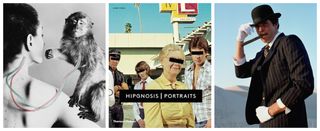
Also included in the book for the first time are outtakes from the Wish You Were Here cover session [in 1975]. Again, when I took all the Hipgnosis files away from Storm’s studio, I found these pictures sealed in a manilla envelope forty-odd years ago. The picture of the guy with the cigar and the bowler hat was an outtake. On the final cover, we took away his face. But in this original picture he was meant to signify the uncaring, money-oriented businessman in the song Have A Cigar.
Powell: Hipgnosis worked with Bad Company from the beginning of their career. They had a saying, ‘Bad company, good company’. They were tremendous fun, but they were a bunch of tearaways and it could get out of hand. One night on tour in Ludwigshafen, Germany, we were in the hotel after the gig. [Drummer] Simon Kirke and [bassist] Boz Burrell were playing the hotel piano, and I was sat with [lead singer] Paul Rodgers, tapping my fingers on the table. Paul told me to stop it, I said why, and carried on. Next thing, he’s clocked me in the face.
I went back to my hotel room, very drunk in a rage, and tore the sink off the wall and smashed the place up. The bed was one of those that if you put a pfennig in, it vibrated. I woke up four hours later, feeling absolutely awful, to see my cowboy boots juddering at the end of the bed. The bed was broken and had been vibrating the whole time.
I had a plane to catch, but I got the dreaded call from manager Peter Grant: “Come and see me, Po. You know what it’s about.” So I went to his office, expecting never to work with the band again. Instead he said, “Answer me one question – did you enjoy smashing up that room?” When I said yes, he said, “Good. We’ll pay the damages, but don’t ever do it again.”
In 1982 Hipgnosis did the cover for [sixth album] Rough Diamonds, and Peter asked me to take some promo shots. By then, Paul and Boz had really fallen out, and there’d been physical fights. I took the band to a disused garage in King’s Cross and soon realised that the atmosphere wasn’t great, and I needed to distract them. So I handed them each a copy of the Evening Standard, surreptitiously set fire to them all with a lighter, and bashed off some pictures very quickly. It broke the ice!
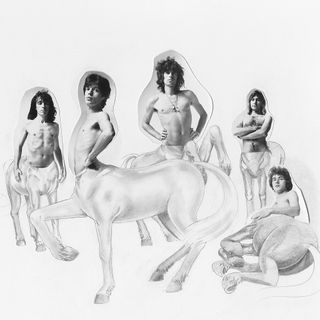
Powell: Paul McCartney always used to play the same game with Hipgnosis, which was to ask us to come up with some ideas, and then come with some of his own. Then he’d say, “You do your idea… but can you do one of mine as well?” It was Paul’s idea to put two snooker balls on the cover of Venus And Mars [1975], but I suggested that we shoot the band for the inside cover in a spacey location with the red and yellow balls somewhere in the picture. So I roamed around California looking for the right location, which is where this shoot comes from.
I toured with Wings in 1976 for what became the Wings Over America live album, taking photos for an Hipgnosis book [Hands Across The Water: Wings Tour USA]. It was Paul’s first US tour since The Beatles and it was like Beatlemania all over again. Security was very tight – we even had an FBI agent travelling with us – because Paul had had threats made against him, and this was way before John Lennon was killed.
Paul wasn’t always easy to be around. He had this laissez-faire, thumbs-up public persona, but, behind that, he was a Beatle – and that came with its own problems. Sometimes he’d get rattled. Once we played cards on the plane. I’m not very good at cards – and we were only playing for matchsticks or a dollar – but Paul was very tired and I won, and I just kept on winning. And eventually Paul got very pissed off and threw the cards in the air and didn’t talk to me for a week. I was very upset because in that claustrophobic touring environment, you can’t afford that type of atmosphere. Eventually, he sensed how upset I was, came over, put his arm around me and we went back to being buddies. It was just tour craziness.
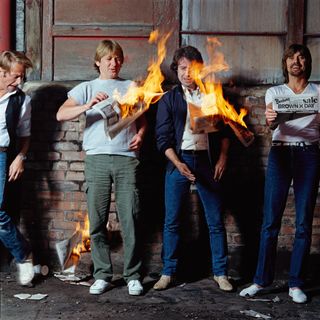
Powell: The leader of UFO was [lead singer] Phil Mogg, and he and Storm got on like a house on fire. It was an unlikely friendship – Storm, the grumpy intellectual, and this heavy metal rock’n’roller. But Phil was very appreciative of Hipgnosis, and up for anything different. He would come swaggering into the studio – and Phil always had a swagger – in his spandex trousers, shouting: “Come on Storm, turn me on, show me something fantastic!”
Phil had a sense of humour about the music biz, and could be very self deprecating. That was the difference between him and, say, Black Sabbath – who we also worked with, but who took themselves very seriously. Phil saw the humour in heavy metal. He always seemed to be a bit tongue-in-cheek about it all, almost as if he knew it could end tomorrow and he’d have to go and become an electrician – not something you’d have dreamt of Ozzy or Tony Iommi saying at the time.
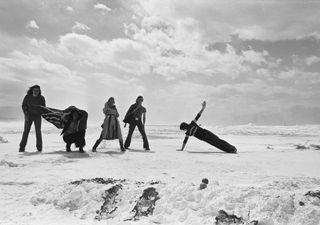
UFO always had the music to listen to, and told us their new album was called No Heavy Petting [1976]. Storm had this idea to do something to do with animals. He told Phil, “There’s this old Delta blues expression – ‘I’ve got a monkey on my back’”. The ‘monkey’ being an addiction. So the idea was to have this girl with a monkey on her back and she needs a fix from the animal. The tube coming out of the girl to the monkey is about an addiction to UFO’s music. It’s the perfect example of the Hipgnosis visual pun.
Hipgnosis Portraits by Aubrey Powell is published by Thames & Hudson, priced at £35.


